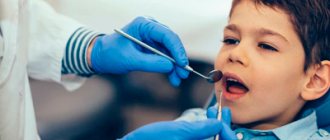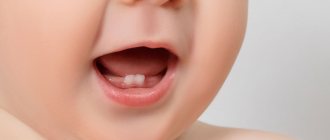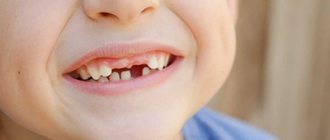Changing children's baby teeth to permanent ones is always an exciting time for parents. This process is quite lengthy and often painful for the child, because it can be accompanied by various inflammations and discomfort. To help parents, for a better understanding of the physiological processes associated with the formation of teeth, dentists offer to look at the pattern of loss of baby teeth in children.
Nature has provided for everything
Losing baby teeth is a natural and inevitable process that everyone goes through in childhood. Most often it begins at 5-6 years of age and passes painlessly. Sometimes the replacement of temporary teeth may begin earlier or, conversely, late. Some deviations from the usual indicators are not always considered a violation, since much depends on the health and physiological state of the child. When he begins to change his teeth, we recommend making an appointment with the dentist, as this is a very important period for the formation of your baby’s bite.
Why can a 7-14 year old child sometimes experience pain when all his teeth are intact?
Yes, this can happen, but in this case the pain occurs not in the tooth itself, but in the jaw, which is growing rapidly at this age. Since permanent teeth are almost twice as large as baby teeth, they need much more space. Therefore, large new teeth can sometimes overlap each other or grow at an angle, getting out of the dentition. As the jaw grows, they align and settle into place. But a qualified specialist can competently assess this situation, as well as the risk of anomalies and developmental defects. That is why in this case you will need to consult an orthodontist.
What you should pay attention to
The child’s body prepares in advance for the period of teeth change. Here are the main signs of the changes taking place:
- mobility and loosening of primary teeth
- redness and swelling of the gums
- the appearance of interdental spaces due to jaw growth
- the rudiments of a permanent tooth become visible
When a baby tooth is replaced with a permanent one, the root gradually dissolves. The process is helped by a new tooth pushing out the temporary one from below.
Usually children and their parents remove the loose tooth themselves. But we recommend contacting a specialist who will provide professional assistance.
Anatomical differences between primary and permanent teeth
As we said above, temporary teeth differ from permanent teeth in a smaller number, as well as in significantly smaller sizes (they are 2 times smaller than permanent teeth).
At the same time, the shape of the crowns of primary teeth is always more spherical, and in the area of the neck of the primary tooth there will always be a noticeably more pronounced narrowing. In addition, temporary teeth are whiter than permanent teeth and often have a bluish tint. Differences between temporary and permanent teeth (description below) –
Anatomical differences:
- Tooth enamel – the enamel of temporary teeth is much less mineralized (saturated with minerals, primarily calcium and phosphates). Therefore, with insufficient oral hygiene, children develop caries almost instantly. In addition, the thickness of the enamel of temporary teeth is approximately 2 times less than that of permanent teeth - this circumstance leads to a very rapid transition of caries to pulpitis. There are also many microcracks and pores on the surface of the enamel of temporary teeth.
- Dentin of the tooth - the dentin layer is located under the layer of tooth enamel, and its thickness is also 2 times less (than that of permanent teeth). The dentin of temporary teeth is lighter, it is less mineralized, softer, and therefore it is much easier to prepare with a drill than the dentin of permanent teeth. Due to the fact that dentin is less mineralized and softer, the carious process in dentin spreads deeper faster, which leads to the rapid development of pulpitis in baby teeth.
- Pulp (neurovascular bundle) - some parents ask: “Are there nerves in baby teeth?” Of course, they exist, but due to the thinner layers of enamel and dentin, the pulp in baby teeth is located much closer to the surface of the tooth. The pulp chamber (tooth cavity), in which the pulp is located, is always larger in primary teeth, and therefore the pulp occupies a relatively large volume in the tooth. And besides, in baby teeth the “pulp horns” (processes) are more pronounced, which creates an additional danger of injury to the pulp during the treatment of caries.
- Roots of teeth – some parents ask: “Do baby teeth have roots?” Of course, they have roots, but they are thinner and widely spaced (at the same time, the root canals and apical openings in baby teeth are wider than in permanent teeth). But the development and growth of the rudiments of permanent teeth leads to the formation of constant pressure on the roots of primary teeth, which leads to their gradual resorption and loss. We hope that our article: Scheme of loss of baby teeth in children was useful to you!
Sources:
1. Dental education of the author of the article, 2. Based on personal experience as a dentist, 3. The European Academy of Paediatric Dentistry (EU), 4. National Library of Medicine (USA), 5. “Pediatric therapeutic dentistry. National leadership" (Leontyev).
In what order do teeth fall out?
The loss of baby teeth occurs in the same order in which they first erupted. First, the child loses the lower and upper incisors, then the lateral molars, and lastly the canines. The replacement of baby teeth with permanent teeth begins at the age of 5.5 years and ends at the age of 13. At the same time, instead of 20 dairy ones, 28 permanent ones grow. There is room for eight new chewing teeth due to the expansion of the jaws. By the way, wisdom teeth most often erupt in adulthood, and for some they do not grow at all.
How do “eights” erupt?
It is impossible to give an unambiguous answer to the question of when wisdom teeth begin to grow and until what age do they grow. Third molars “come into the world” in the period from several months to 2-3 years, causing a lot of unpleasant sensations. When the “eights” begin to grow is influenced by many factors - in particular, the number of bone buds, heredity, and the anatomical features of the jaw (its shape). Due to the fact that third molars often create a certain discomfort - they affect the functioning of the TMJ, provoke sinusitis, and “displace” neighboring units of the dentition - they are often removed.
The main indications for extraction are:
- persistent hyperthermia (2–3 days) during the growth of wisdom teeth;
- acute inflammation of the gums (gingivitis) at the site of eruption;
- severe pain that makes eating difficult.
Anatomical features (shape) of the jaw, heredity and a number of other factors determine the timing of teething
What to do if a tooth does not fall out in time
According to statistics, in 20-30% of cases, children experience a “shark smile” when the permanent tooth has already erupted and is growing, but the milk tooth has not yet fallen out. Clinical studies have proven that in such a situation, parents should not hesitate to go to pediatric dentistry. The doctor will carefully examine your child's mouth and remove the temporary tooth. If you do not contact the dentist in a timely manner, double dentition can lead to improper formation of the bite, impaired diction and the functioning of the digestive system. In addition, with a “shark smile” it is difficult for a baby to bite and chew food, particles of which remain between the teeth and under the gum. As a result, inflammatory processes and caries occur. All this can be avoided by making an appointment with a specialist.
How to relieve your baby's condition
Many young parents are wondering how to relieve the unpleasant symptoms that accompany the “birth” of milk units. The simplest measure is to apply cold (a piece of ice) to the “working” gum. Dental gels or ointments can also come to the rescue, relieving pain, swelling, and stopping the inflammatory process. Important: any medications should be used only with the permission of a pediatrician (pediatric dentist).
Thus, pharmacies sell special gels with lidocaine and inert fillers (menthol, astringents, flavorings) intended for use exclusively during teething. Examples of such tools:
- Kalgel (contraindicated for diathesis).
- Dentinox.
- Kamistad.
- Holisal.
- Mundizal.
General recommendations for use: a small amount of the local drug should be applied to the “working gums” 3-4 times a day for no longer than 3 days in a row.
Orthodontic treatment – caring for the future
Some parents do not attach importance to the fact that the baby tooth has not yet fallen out, but the permanent one is already emerging. Or, on the contrary, the temporary one is lost early, and the tooth that replaces it does not grow. If you notice deviations, we recommend that you contact an orthodontist as soon as possible, who will provide effective treatment.
For example, with the premature loss of a baby tooth, the free space is very quickly taken up by neighboring teeth. There is not enough space for a permanent one. Therefore, it is very important when forming a temporary occlusion to fill such gaps, preventing the occurrence of an occlusion anomaly. To hold space for a permanent tooth, orthodontics uses a plate with artificial teeth. For single defects, a non-removable “ring-loop” design is most often used. The device does not cause discomfort, and the child wears it until the permanent tooth erupts.
The product manufacturing process is standard: impressions are taken, models are made, and the design is created in the laboratory within two weeks. Its fixation takes 15-20 minutes. After installing the device, you do not need to drink or eat for 2 hours. It is better to limit the consumption of “pulling” foods - toffees, chewing gum, etc.
Drop order
The dropout pattern looks like this:
- 5-7 years - central incisors;
- 7-8 - lateral incisors;
- 9-11 - first molars of the upper jaw and second molars of the lower jaw;
- 9-12 - fangs;
- 10-13 - second molars of the upper dentition and first lower ones.
The diagram shows that the timing of changing units is quite arbitrary and quite long. This is why some children already have a permanent bite at the age of ten, while others still walk around at the age of 12 with actively loose baby teeth.
Doctors are our pride
We did the research and found out why they trust us. In reviews
On our website, parents note the highly qualified doctors who have knowledge of several related areas and have extensive experience
working with children
. This allows you to see the clinical picture as a whole and plan treatment correctly.
In 2022, family dentistry "DOMOSTOM" in Domodedovo entered the TOP 100 private children's dental clinics in Russia according to the rating of the expert magazine about dentistry Startsmile with the support of Kommersant Publishing House.
Our clinic’s team of professionals knows how to help your child. Sign up for a consultation with us. Attentive doctors will tell you in detail about the condition of the baby’s oral cavity and answer all questions.
At what age should a bite be corrected?
You can start correcting your bite at 4-5 years of age. In this case, the growth of permanent teeth will be even, in the place intended by nature. Therefore, there is no need to carry out subsequent long-term bite correction. In any case, if there is a malocclusion, the problem can be eliminated efficiently and as quickly as possible by contacting a qualified orthodontist as early as possible.
| Teeth | Dairy (temporary) | Permanent | ||
| Jaw | Lower | Upper | Lower | Upper |
| Central incisors | 6-12 months | 8-12 months | 6-7 years | 6-8 years |
| Lateral incisors | 10-16 months | 9-13 months | 7-8 years | 7-8 years |
| Fangs | 17-23 months | 16-22 months | 9-10 years | 11-12 years old |
| First Premolars | — | — | 10-12 years | 10-11 years |
| Second Premolars | — | — | 11-12 years old | 10-12 years |
| First Molars | 14-18 months | 13-19 months | 6-7 years | 6-7 years |
| Second Molars | 23-33 months | 25-33 months | 11-12 years old | 11-13 years old |
What to do when teething?
The first teeth erupting will cause discomfort in the child, and this is a natural process. During this period, salivation increases, and a runny nose may occur due to the eruption of the upper teeth. The normal pace is for new teeth to appear every few weeks.
Be prepared for the fact that the child will be capricious and refuse to eat, and his temperature may rise. To make this period easier, you can use special teething toys. During this period, the gums become inflamed and cause discomfort - they can itch and hurt. Talk to your dentist: There are safe cooling gels for children that can help reduce the intensity of teething and teething symptoms in children.
It is also recommended to replace drinks with plain water. Juices and other drinks that contain sugar create an acidic environment in the mouth. Because of this, an inflammatory process may begin. Care should be taken to disinfect pacifiers and toys that children may put in their mouths.
The first teeth appear at the age of six months. The first chewing teeth appear between the ages of 1 and 1.5 years. Fangs are cut between the ages of 2 and 2. After this, by the age of 3, the following chewing teeth appear. Each new group requires attention. Thus, it is important to brush your chewing teeth well after eating, since the enamel of baby teeth is quite weak. Retention of food on the surface can easily cause inflammation.
It is also important to ensure that the child weans the habit of the pacifier and stops putting his fingers in his mouth. If this does not happen, an incorrect bite will be formed.
Daily doctor's advice on caring for baby teeth:
- Start brushing your baby's teeth only after they have erupted; use a special brush for babies.
- When your child turns one year old, buy a brush with soft bristles and toothpaste without fluoride; it will not harm the child if he swallows it.
- Brush your baby's teeth 2 times a day (morning and evening)
- Don't put off going to the dentist. They should be regular, even if there are no signs of concern.
- Include more fresh greens, fruits and vegetables in your diet.











